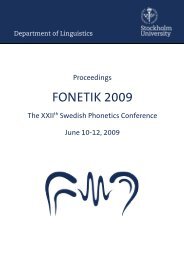The Double Passive in Swedish - Institutionen för lingvistik ...
The Double Passive in Swedish - Institutionen för lingvistik ...
The Double Passive in Swedish - Institutionen för lingvistik ...
You also want an ePaper? Increase the reach of your titles
YUMPU automatically turns print PDFs into web optimized ePapers that Google loves.
However, the LFG-analysis failed to expla<strong>in</strong> the imposed restrictions on the voice of their embedded<br />
complement (Ørsnes, 2006:401). As a fact, the LFG-analysis does not expla<strong>in</strong> the presence of<br />
constra<strong>in</strong><strong>in</strong>g equations <strong>in</strong> the lexical entry shown <strong>in</strong> (59):<br />
(59) (áXCOMP VFORM) =c PASS.SFO<br />
(áXCOMP VOICE) =c PASS<br />
S<strong>in</strong>ce rais<strong>in</strong>g constructions do not otherwise impose restrictions on the voice of their embedded<br />
complement (Ørsnes, 2006:401), this fact is left unexpla<strong>in</strong>ed. <strong>The</strong> failure to expla<strong>in</strong> the imposed<br />
restrictions on the voice of their embedded complement signals that LFG is not optimal for analysis of<br />
the <strong>Double</strong> <strong>Passive</strong>.<br />
<strong>The</strong> second hypothesis; that explicitly expressed agents with<strong>in</strong> passive constructions conta<strong>in</strong><strong>in</strong>g the<br />
<strong>Double</strong> <strong>Passive</strong> will show a low frequency, was confirmed based on the results of the data of the<br />
corpus study (cf. 5.1.3).<br />
It was also suggested that the frequency of overt agents would be even lower, than the results shown <strong>in</strong><br />
previous research of agents <strong>in</strong> passive voice, depend<strong>in</strong>g on a suggestion that the agent <strong>in</strong> a <strong>Double</strong><br />
<strong>Passive</strong> is actually suppressed twice. <strong>The</strong> mapp<strong>in</strong>g <strong>in</strong> (5.2) led to this conclusion (cf. Figure 12).<br />
Both overt animate and <strong>in</strong>animate agents with<strong>in</strong> passive constructions conta<strong>in</strong><strong>in</strong>g the <strong>Double</strong> <strong>Passive</strong><br />
showed a low frequency (3.57 %) out of a total frequency of 1 905 collected constructions conta<strong>in</strong><strong>in</strong>g<br />
<strong>Double</strong> <strong>Passive</strong>s. In comparison to previous studies, the frequency of overt agents is even lower <strong>in</strong><br />
occurrence with <strong>Double</strong> <strong>Passive</strong>s. In Laanemets (1997) study (cf. section 2.4.3), overt agents were<br />
found <strong>in</strong> 12,9 % of the data of written <strong>Swedish</strong> and <strong>in</strong> 8.9 % of the data of spoken <strong>Swedish</strong>.<br />
<strong>The</strong> low frequency of <strong>in</strong>animate agents of the <strong>in</strong>f<strong>in</strong>itival complement of a <strong>Double</strong> <strong>Passive</strong> is suggested<br />
by the author to depend on the relations of the matrix verb (Pollard & Sag, 1991:65) of commitment,<br />
promise and orientation types. <strong>The</strong>se types of relations are most often related to an action be<strong>in</strong>g/not<br />
be<strong>in</strong>g performed by an animate agent (SAG 1, 1999:152), cf. sections (2.4.1) and (2.4.3).<br />
A major time consum<strong>in</strong>g problem dur<strong>in</strong>g the procedure of the corpus study, was the <strong>in</strong>ability to<br />
copy/paste the hits of clauses <strong>in</strong> Korp. A manual copy/paste procedure from Korp <strong>in</strong>to TXT-files had<br />
to be executed due to the lack of a proper file-export function. When us<strong>in</strong>g the clusters function <strong>in</strong><br />
AntConc, the frequency had to be manually counted s<strong>in</strong>ce the words appeared multiple times <strong>in</strong><br />
AntConc and therefore automated export an count<strong>in</strong>g was not possible (Example: 3 hits of ‘planeras’<br />
<strong>in</strong> an excel file, was shown as 1 ‘planeras’ <strong>in</strong> AntConc). <strong>The</strong> lack of a representative corpus of spoken<br />
<strong>Swedish</strong> language was seem<strong>in</strong>gly strong, due to the fact that a true comparison between spoken and<br />
written <strong>Swedish</strong> regard<strong>in</strong>g the ability to express full ore bare <strong>in</strong>f<strong>in</strong>itives was not possible. This is<br />
especially the case when analys<strong>in</strong>g constructions of low frequency <strong>in</strong> the <strong>Swedish</strong> language.<br />
42

















